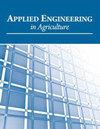Inversion of the Optical Properties of Apples Based on the Convolutional Neural Network and Transfer Learning Methods
IF 0.8
4区 农林科学
Q4 AGRICULTURAL ENGINEERING
引用次数: 1
Abstract
Highlights Convolutional neural network and MMD transfer learning methods are applied in inversion of optical properties. The classification accuracy of apples’ peel and pulp absorption coefficients are 84.61% and 92.47%, the accuracy of peel and pulp scattering coefficients are 83.56% and 86.53%, respectively. The depth optical characteristics can better reflect brix and moisture of apple then optical properties and hyperspectral data, the correlations are in the form of 0.98 and 0.98. Abstract. An inversion of optical properties is an important test for determining the quality of fruit. The conventional inversion model of the optical properties uses measured hyperspectral images as the training data. Studies show that the conventional machine learning method for inverting the optical properties results in low inversion accuracy, especially with curved models. Hence, the present study uses a convolutional neural network scheme to train the simulated hyperspectral images. Moreover, the maximum mean discrepancy (MMD) transfer method is used to transfer the simulated hyperspectral images to the measured hyperspectral images of apples. To evaluate the performance of the proposed method, the present study uses it to classify a variety of an apple’s optical properties, including the peel absorption, pulp absorption, peel scattering, and pulp scattering coefficients. The classification accuracies of the peel and pulp absorption coefficients are 84.61% and 92.47%, respectively. The classification accuracies of the peel and pulp scattering coefficients are 83.56% and 86.53%, respectively. These inversion results are compared with convolutional neural networks, neural networks, and support vector machines with measured hyperspectral images. It was found that the proposed inversion model is an effective scheme for optical property inversion. To prove the necessity of optical property inversion, the least squares, decision tree and random forest regression methods are performed to analyze the correlation between the depth of optical characteristics and the brix and moisture. The present study shows that these correlations are in the form of 0.98 and 0.98. The correlation coefficients increase by 0.36 and 0.25 compared to the measured hyperspectral images. The conclusions show that the proposed inversion model is an effective scheme for apple optical property inversion. Keywords: Apple tissue, Hyperspectral, Optical property inversion, Quality inspection.基于卷积神经网络和迁移学习方法的苹果光学特性反演
重点介绍了卷积神经网络和MMD迁移学习方法在光学性质反演中的应用。苹果果皮和果肉吸收系数的分类准确率分别为84.61%和92.47%,果皮和果肉散射系数的分类准确率分别为83.56%和86.53%。深度光学特性比光学特性和高光谱数据更能反映苹果的白度和水分,相关性分别为0.98和0.98。摘要光学性质的反演是测定水果品质的一项重要测试。传统的光学性质反演模型采用实测高光谱图像作为训练数据。研究表明,传统的机器学习方法反演光学特性的精度较低,特别是对于弯曲模型。因此,本研究采用卷积神经网络方案对模拟的高光谱图像进行训练。利用最大平均差(MMD)转换方法,将模拟高光谱图像转换为苹果的实测高光谱图像。为了评估该方法的性能,本研究使用该方法对苹果的各种光学特性进行分类,包括果皮吸收、果肉吸收、果皮散射和果肉散射系数。果皮吸收系数和果肉吸收系数的分类准确率分别为84.61%和92.47%。果皮散射系数和矿浆散射系数的分类精度分别为83.56%和86.53%。这些反演结果与卷积神经网络、神经网络和支持向量机与测量的高光谱图像进行了比较。结果表明,所提出的反演模型是一种有效的光学性质反演方案。为了证明光学特性反演的必要性,采用最小二乘、决策树和随机森林回归方法分析了光学特性深度与糖度和水分的相关性。本研究表明,这些相关关系的形式为0.98和0.98。与实测高光谱图像相比,相关系数分别提高了0.36和0.25。结果表明,所提出的反演模型是一种有效的苹果光学性质反演方案。关键词:苹果组织,高光谱,光学性质反演,质量检测
本文章由计算机程序翻译,如有差异,请以英文原文为准。
求助全文
约1分钟内获得全文
求助全文
来源期刊

Applied Engineering in Agriculture
农林科学-农业工程
CiteScore
1.80
自引率
11.10%
发文量
69
审稿时长
6 months
期刊介绍:
This peer-reviewed journal publishes applications of engineering and technology research that address agricultural, food, and biological systems problems. Submissions must include results of practical experiences, tests, or trials presented in a manner and style that will allow easy adaptation by others; results of reviews or studies of installations or applications with substantially new or significant information not readily available in other refereed publications; or a description of successful methods of techniques of education, outreach, or technology transfer.
 求助内容:
求助内容: 应助结果提醒方式:
应助结果提醒方式:


